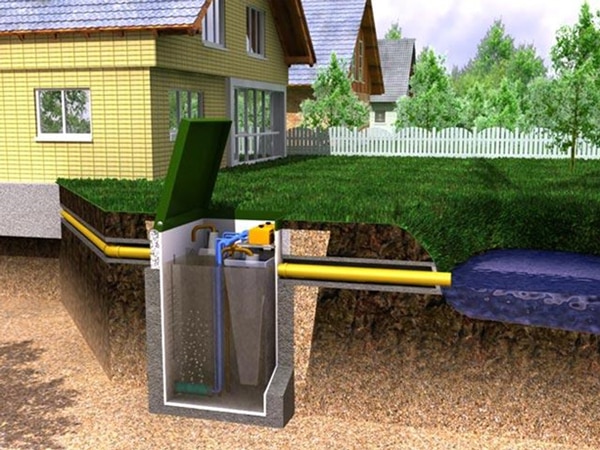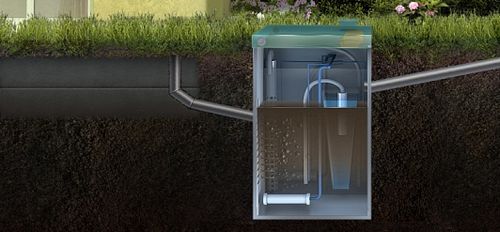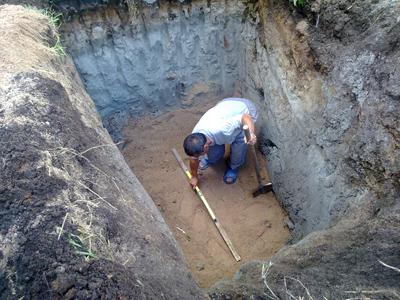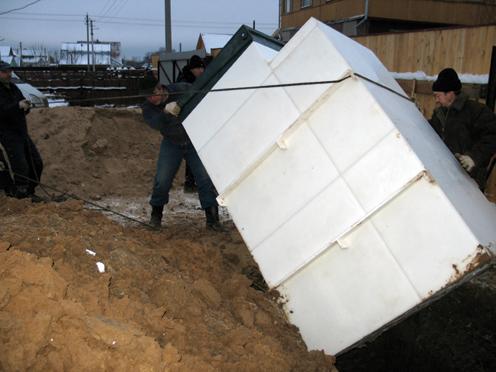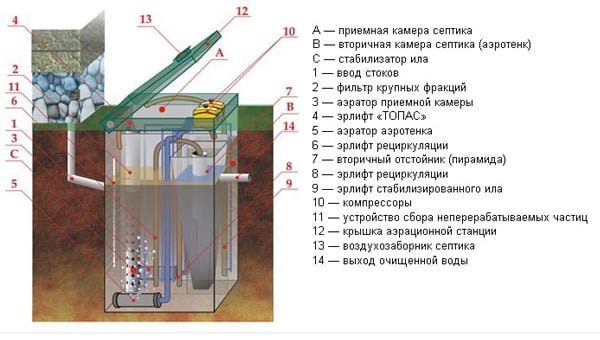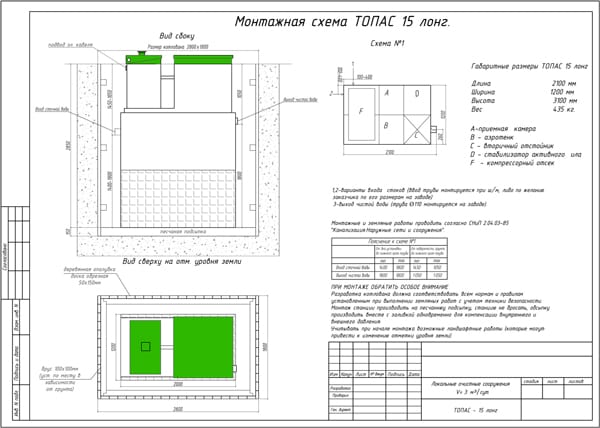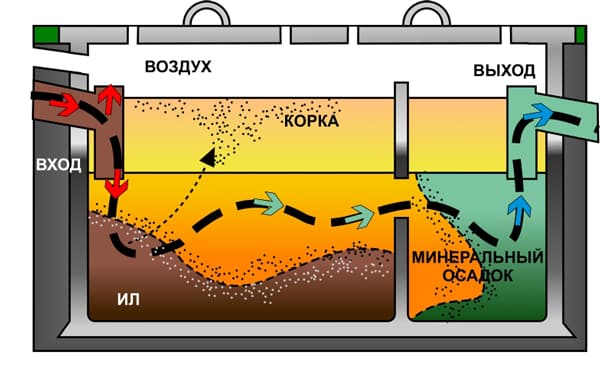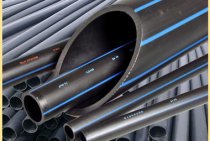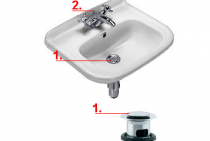Rules for operation and maintenance
After installing all the constituent elements of the Topas cleaning system, start-up work is carried out. For the first time, it is better to leave this procedure to professionals, watching their work.
Ongoing maintenance includes the following activities.
- Compressor membranes are cleaned every 2-3 years.
- Once every 12 years, the aeration equipment is replaced.
- With year-round use of the septic tank, once every 3-4 months it is necessary to remove the spent sludge from the stabilizer. To do this, use a drainage pump, you can use the built-in pumping equipment of the station. At the same time, undecomposed sediments can be removed from the primary chamber with a net and the hair collector located in the aeration tank can be cleaned.
- Every 1-2 years it is recommended to carry out a comprehensive maintenance of the treatment plant. It consists not only in pumping out silt and other sediments from all chambers, but also in the simultaneous washing of each container with clean water.
Topas septic tank cleaning
The comprehensive service also includes cleaning the coarse fraction filter and checking the float mechanism of the first chamber, which is responsible for turning the compressor on and off. For revision, you just need to forcefully raise and release the float and see how the compressor works.
It is also important to clean the pumping equipment compartment, after removing the compressors from there, rinse all hoses and pipes. After completing all the cleaning procedures and installing the equipment in place, it is necessary to fill the septic tank with clean water by two thirds
You can start further operation
After completing all the cleaning procedures and installing the equipment in place, it is necessary to fill the septic tank with clean water by two-thirds. You can proceed to further operation.
Otherwise, the Topas septic tank works effectively offline.
Installation
You can buy a Topas septic tank immediately with installation from the manufacturer or other companies (Mosseptic), but then its price will be a little higher, so even experts are advised to do the installation themselves. The first step is to decide what distance from the house should be during installation. These data are calculated individually, they depend on the size of the septic tank and the total area of the site, but, in most cases, they are at least 4 meters from the foundation.
Photo - installation
Instructions on how to install a Thomas septic tank with your own hands:
First, the site is marked out and a pit is dug out at the designated place. It should be 10 centimeters larger than the size of the treatment plant itself. A sand-gravel pillow is installed at the bottom of the pit, its height is up to 20 centimeters
A very important feature of creating a pit for a septic tank is that the pit is by no means filled with mortar;
After that, a septic tank is installed in the pit itself. If you have chosen a small model (Topas 3 or 5), then the system can be easily installed by yourself
But the Series 8 device weighs over 350 kilograms - lifting equipment will be needed here; After installing the septic tank, you need to connect the sewer outlet to the pipe, the scheme varies depending on the number of outlets. For connection, a pipe with a certain diameter is used (its calculation is based on the number of people and devices that the sewer system serves); Topas stations are of two types: autonomous and those that need power supply (like models of the Tver-m septic tank). Comparison of these systems in terms of performance is almost equivalent, but electrical equipment has a certain cost of electricity - 1.5 kW. Also, to connect it, you will need to additionally run a power cable.
The first year after installation, maintenance is carried out by the manufacturer or dealer, the subsequent years are carried out by you.Also, the first 12 months of the warranty, the manufacturer replaces broken parts without any problems.
Each cleaning station has its own technical characteristics, the following modifications are currently available:
| Topas 3 | 3 users, one outlet from the toilet, shower, sink in the kitchen or bathroom, washing machine. |
| 5 | 5 consumers, one drain from the toilet, shower, two sinks in the kitchen and bathroom, washing machine. |
| 8 | 8 users, one outlet from the toilet, two from the shower, three for sinks in the kitchen and bathroom, one for the washing machine. |
| 10 | 10 users, 2 showers, 5 sinks, 3 toilets. |
| 20 (long) | 20 consumers, 6 showers, 10 sinks, 10 toilets. |
Instructions for use of the septic tank Topas:
- It is imperative to periodically pump out the sludge, otherwise the storage tank will overflow, and sediment residues will begin to fall into the filtered liquid;
- There must always be a certain level of water in the sump;
- Compressor membranes need to be changed every two years;
- Cleaning the Topas septic tank, as well as the Astra, Yubas, Yunilos or Tank stations, in most cases, is carried out by specialists, and independent work is also allowed;
- The bacteria filter should be replaced every 12 years.
Related video:
Model range of septic tanks Topas
The models of this cleaning station differ in capacity, which depends on how many people will operate the sanitary equipment of a residential building.
The numerical indicator in the model name indicates the number of users for which the septic tank is designed. Also, in each model, two main modifications are provided, which differ from each other in the height of the input and output of drains, and hence the height of the septic tank itself:
- the Standard model is suitable for the case of introducing a supply pipe at a depth of 0.4 - 0.8 m;
- the Long model is applicable when it is necessary to deepen the sewer pipe by 0.9 - 1.4 m.
There are modifications with forced withdrawal of treated water. They are equipped with a pump.
For private houses, 5, 8 and 10 models of the Topas septic tank are most often used, so we will focus on a brief description of these particular varieties. In order not to repeat ourselves, we indicate that all these models have the same width, which is 1.2 m.
The Topas 5 septic tank is designed for a salvo discharge of 0.22 m 3, and a capacity of 1 m3. Weight, depending on the height of the tank and the presence of a pump for forced pumping of treated wastewater, ranges from 0.23 - 0.31 tons. The height of standard models is 2.6 and 2.5 m for gravity and forced evacuation of wastewater, respectively. The height of the elongated model is 3.1 m. The length of the septic tank is about 1 m. The estimated cost, depending on the height of the tank and the presence of a pump, ranges from 80 thousand rubles.
Topas 5
The Topas 8 septic tank copes with a salvo discharge of 0.44 m3 and has a capacity of 1.5 m3. The weight of the septic tank of this model, depending on the modification, ranges from 0.35 - 0.41 tons. The length is about 1.5 m, and the height for standard systems is approximately 2.5 m, and for elongated systems - 3.1 m. Price range is 85-105 thousand rubles.
Septic tanks "Topas 10" successfully operate with a capacity of 2 m3, and the volume of burst emission can be equal to 0.76 m3. The weight of the container with equipment differs for modifications in the range of 0.50 - 0.62 tons. The height of this septic tank is the same as that of the eighth model, and the length is 2.1 m.
In addition, the Topas 10 septic tank, in addition to standard models, has an elongated tank with a reinforced structure that can withstand strong ground pressure.
We also note that among the Topas treatment plants there are varieties that can serve several houses and even small populated areas with up to one and a half hundred people. In this case, the installation must be left to professionals. Small structures can be installed independently.
Installation work
Topas 8 - autonomous biological wastewater treatment system
Before the preparatory and installation work themselves, it is necessary to correctly select the location of the septic tank in accordance with certain conditions:
- the distance to the treatment plant from residential buildings should be at least 5 m, but not exceed the threshold of 10-15 m;
- if the conditions of the area force you to install a septic tank further from the house, then it is recommended to install an inspection well on the external sewer pipeline;
- an inspection well will be required if the supply pipe has bends of more than 30 degrees, so it is better that the pipeline does not have turns.
Having decided on the place, you can proceed to the installation work.
Step 1. Dig a pit using equipment or manually. The width and length of the pit for the container should be approximately 50-60 cm larger than the corresponding dimensions of the septic tank. The depth of the pit is made equal to the height of the septic tank, even though a fifteen-centimeter sand layer will be poured at the bottom. After all, it is 0.15 m that the septic tank should rise above the ground to facilitate its maintenance and prevent flooding of the station during the spring flood. If an additional concrete base is installed at the bottom, then its height must be taken into account, determining the depth of the pit.
Step 2. To prevent shedding of the pit, its walls are reinforced with formwork.
Step 3. At the bottom of the pit for the Topas septic tank, a sandy backfill 15 cm thick is made, which must be leveled to the mounting level
If the septic tank is installed in places with water-saturated soil or with a seasonal rise in GWL, then it is important to additionally fill or install a ready-made concrete base at the bottom of the pit. A septic tank is further attached to it
Sand pad alignment
Step 4 Holes for pipelines are made in the wall of the tank.
Step 5. A septic tank is released into the prepared pit. If we are talking about 5 or 8 models, then no more than 4 people should be involved to carry out all the work. To do this, they thread slings through the eyes on the stiffening ribs of the capacity, holding for which they release the septic tank into the pit.
The process of releasing the septic tank into the pit
Step 6 Prepare a trench for laying a pipe from the house to the septic tank. The depth of the ditch must ensure that the pipeline passes below the zero ground temperature point typical for the winter period. If this fails, then the pipe will need to be insulated. A sand backfill is also made at the bottom of the trench, which is leveled in such a way that the laid pipe runs at a slope of 5-10 mm per linear meter.
Septic tank leveling
Step 7. Lay the supply pipe and connect it to the septic tank through the pipe inserted into the prepared hole in the tank wall. All connections are additionally sealed with a special plastic cord that comes with the station. To do this, use a building hair dryer. At the same stage, the septic tank is connected to the power cable and compressor equipment is installed.
Step 8. A ditch is being prepared for a pipe that already drains waste after cleaning into a receiving tank, reservoir, filtration well and other discharge points. A pipe is laid at an angle in it, if the removal of water is planned to be carried out by gravity. For forced evacuation of the liquid in the slope is not necessary. The outlet pipeline is connected to the septic tank, all connections must be tight.
Step 9. Fill the septic tank with sand or a mixture of cement and sand. At the same time, clean water is poured into the tank itself, its level should be 15-20 cm higher than the backfill level. Every 20-30 cm, the backfill is carefully rammed manually. The space between the upper 30 cm of the septic tank and the foundation pit is filled with fertile soil and the turf is laid back around to restore the landscape.
Step 10. Ditches are filled up with inlet and outlet pipes laid in them.
Principle of operation
Bioseptic Topas is an autonomous station for biological treatment and wastewater filtration, which works thanks to a filter with a certain bacteriological background (content). This is an ideal solution for a country house or cottage, because anaerobic bacteria do not cause any harm to the environment and do not disturb the biological climate of the area. This septic tank is completely autonomous, that is, it does not require a network connection and works thanks to exclusively mechanical spare parts.
Photo - design
The principle of operation of the Topas septic tank is based on multi-chamber treatment of waste liquid. From the sewer, water enters the installation chamber of the structure. Here primary conservation and filtration of wastewater is carried out. At this stage, the device separates solid fecal matter or other particles from liquid and defends them. After the compressor pumps the liquid into the second chamber. It is here that the sewer is exposed to bacteriological compounds that purify and filter the liquid.
Photo - drawing
During the operation of this septic tank, silt and other solid particles settle in the chambers. After cleaning, they are additionally filtered and melted into a pyramid, which is a classic sump. The Topas septic tank is very easy to use, its maintenance does not include any additional measures, except for the inspection and cleaning of the sump pyramid.
Photo - the principle of operation
Advantages of a septic tank:
- Ease of use;
- The cleaning efficiency reaches 99%. In comparison, many other products do not purify water by more than 60%;
- Complete security;
- Durability of work. The average service life is more than 30 years;
- The sludge that settles at the bottom of the settling chamber does not get into the rest of the liquid and is often used by home owners to fertilize the site;
- The connection can be made independently.
Photo - general view of Topas 3
The disadvantages that the Topas septic system from Poplar has:
- High price. The price is due to the need to use special aerobic bacteria. The same manufacturer has a more affordable analogue - Topas Bioksi, which uses other microorganisms;
- The need for regular maintenance to ensure efficient operation. This includes cleaning the sump, checking the condition of the chambers and the bacteriological filter;
- For preventive cleaning, you need to use special mild detergents.
For example, for cottages with more than 5 people, the Topas 8 system is used, it needs to be cleaned once a month. Topas 5 is cleaned every 2 months. In addition, in winter it is necessary to carry out additional warming of systems, since bacteria can suffer as a result of hypothermia.
